Don't know what to do with all those tomatoes? Make sun-dried tomatoes! They are so expensive at the store! I made these last year and they turned out great. I'm looking forward to having more! I dry them and then put them in a quart freezer bag and just throw them in the freezer. I don't put them in oil or anything and they are just great. I used this RECIPE.
I
Step 1 - Selecting the tomatoes
It's fun to go pick your own and you can obviously get better quality tomatoes!
At right is a picture of tomatoes from my garden - they are so much better than anything from the grocery store. And if you don't have enough, a pick-your-own farm is the place to go!
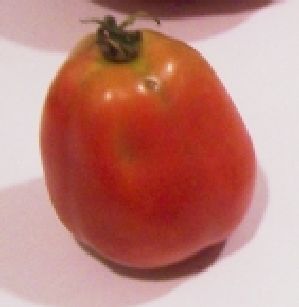 The picture at right shows the best variety of tomato to use: Roma; also called paste tomatoes. They have fewer sides, thicker, meatier walls, and less water. And that means thicker sauce in less cooking time!
The picture at right shows the best variety of tomato to use: Roma; also called paste tomatoes. They have fewer sides, thicker, meatier walls, and less water. And that means thicker sauce in less cooking time!
Also, you don't want mushy, bruised or rotten tomatoes!
Step 2 - (Optional) Removing the tomato skins
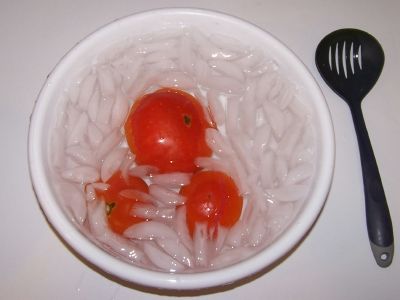 If you do not want to remove the skins, skip to step 4. This is completely optional; some people prefer them with skins, some without. The type you buy in the stores usually has the skins intact.
If you do not want to remove the skins, skip to step 4. This is completely optional; some people prefer them with skins, some without. The type you buy in the stores usually has the skins intact.
Here's a trick you may not know: put the tomatoes, a few at a time in a large pot of boiling water for no more than 1 minute (30 - 45 seconds is usually enough)
then....
Plunge them into a waiting bowl of ice water.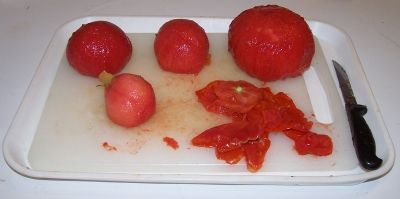

This makes the skins slide right off of the tomatoes!
With a gentle tug, the skins should practically slide off the tomatoes.
 Step 3 - Removing bruises and tough parts, and cut in half
Step 3 - Removing bruises and tough parts, and cut in half
Cut the tomatoes in half lengthwise.
Cut out the tough part around the stem and any bruised or soft parts.
I usually then cut the tomatoes in half again, so I get four lengthwise quarters from each tomatoes. It just depends how big or small you want the final dried pieces to be. Usually they shrink to 1/4 their original size.
 Step 4 - (Optional) - Remove the seeds
Step 4 - (Optional) - Remove the seeds
I generally don't bother with Roma-type tomatoes, they have so few seeds, anyway. If I'm using regular Big Boy, beefstake tomatoes, then sometimes I do. Just scoop them out with a spoon or with a nudge from your finger!
Step 5 - Drying the tomatoes
As I said at the beginning, you have 3 choices: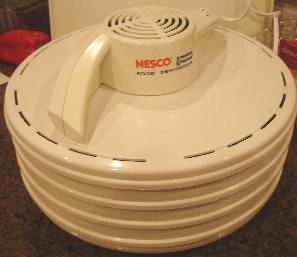

- A Food dehydrator - which is the easiest way, and since it is designed for this purpose, yields the most consistent results. I learned this through experience! Also, those with adjustable thermostats (temperature control and a timer are best - more expensive, but, as Borat might say "very nice!" See this page for food dehydrator makes and models and ordering information.
- An oven - everyone has one of these, so that means you need no additional equipment
- A car (well, or truck, suv, minivan, etc.) and a very hot , sunny day.
Regardless of the drying method you use, you spread the tomato slice out on their trays and you may opt to sprinkle them with salt or dried herbs (basil, thyme and/or oregano are commonly used).
Here are the specific directions for each method: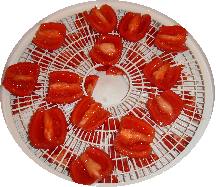

- Food dehydrator: Arrange the pieces on each rack so that air can circulate, preferably with the pieces not touching each other, but there's no need to become obsessive about it. Some people prefer to sprinkle the tomatoes with sea salt, kosher salt and/or some spices (typically basil). Turn the dehydrator on and enjoy the aroma. If your food drier has a thermostat, set it for 140 degrees F. It will take 3 to 8 hours. See "how to tell when they are done" in step 7, below.
- Oven: preheat the oven to 150 degrees F (65 degrees C or gas mark 1). If you don't have these settings, just use the lowest setting you've got. Arrange the tomatoes on cake racks, spread out, not touching each other. Cookie sheets will work if you don't have cake racks or screens - but you need to flip or stir the tomatoes once in a while to expose the other side of them. Some people prefer to sprinkle the tomatoes with sea salt, kosher salt and/or some spices (typically basil). Close the oven. It takes about 10 to 20 hours, but you'll need to check periodically, including rotating the shelves and moving them up or down to get even heating. If you want to speed it up, you can bump the heat up to as high as 200 degrees F ( 93 degrees C), but you'll need to watch them much more closely. See "how to tell when they are done" in step 7, below.
- Automobile and a hot sunny day: It sounds strange, but the same stifling hot car that burns your legs makes an excellent food dryer. Spread the tomato slices out on shallow trays (they work better than cookie sheets, since you don't need to worry about leaking juice!). Cover them loosely with cheesecloth to keep any potential for bugs to come in contact. Put the trays on the dashboard of your car and roll all the windows up and park in the sunniest spot you've got. It's best to start in the morning and let it go to sunset. It may take 2 days - bring the tomatoes in the house overnight. Some people prefer to sprinkle the tomatoes with sea salt, kosher salt and/or some spices (typically basil). but you'll need to check periodically. See "how to tell when they are done" in step 7, below. Note to Al Gore: If you dry tomatoes in one of your limousines or private jet, it might count as a part of your carbon offset! :)
Step 6 - How to tell when they're done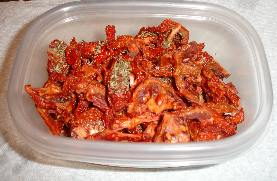
The amount of time it takes depends on the water content of the tomatoes, the thickness of the slices, and how well the air is able to circulate around them. When done, the tomatoes should be flexible, like a raisin from a fresh bag; not brittle. Most describe them as leathery with a deep red color, without free water or a tacky feeling.
Step 7 - Cool, then Fill the Zipper-type bags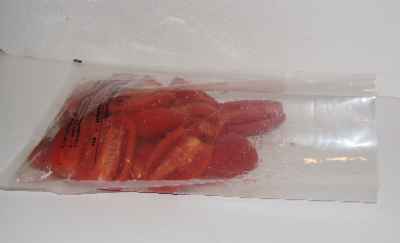
Let the tomatoes cool to room temperature (about 20 to 30 minutes), then fill the bags. Don't overfill the bags, leave a little room for expansion. Do try to avoid leaving any air pockets! A vacuum bag is shown at left, but you can use ziploc (or similar) bags, shown below. But be sure to squeeze out the extra air (below left is before, below right is after squeezing out the excess air).


No comments:
Post a Comment